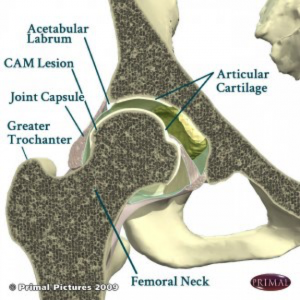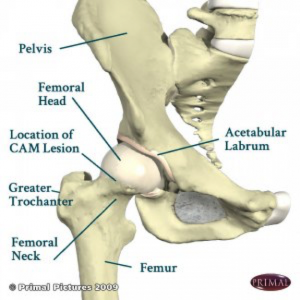Femoral Acetabular Impingement (FAI) and Labral Tears
The hip joint functions mechanically as a ball, called the femoral head, and a socket, called the acetabulum. Femoroacetabular Impingement (FAI) occurs when the femoral head, or head of the thigh bone, restricts the range of motion in the cup, or acetabulum, and is accompanied by pain. This range of motion restriction is due to an abnormal impact between the femoral head and the acetabulum due to either the formation of excess bone on the femoral head or bone overgrowth on the acetabular rim. This condition occurs either during normal bone growth development or as the result of trauma to the hip.
The impact of impingement between the femoral head and the acetabulum can damage the cartilage and the labrum of the hip joint. The symptom first noticed by patients is typically pain near the groin area after walking or sitting for an extended time. Pain can manifest as a sharp sensation, dull ache, or also be felt in the buttocks or side of thigh.
Diagnostic imagery is used to diagnose impingement. X-rays allow the surgeon to view any abnormal bone structure on either the femoral head or acetabulum, and MRI (magnetic resonance imagery) can reveal damage to the soft tissues between the bone surfaces. Occasionally, a CT scan is required to better define the bone structure.
The labrum is the soft cartilage ring lining the rim of the hip socket, or acetabulum. This cartilage can be torn as a result of any injury to the hip joint, or even wear from repetitive athletic activities. Certain other conditions of the hip can increase the risk of labral tears, including:
- Femoroacetabular Impingement Syndrome (FAI), which occurs when there is impingement of the bone from the femur on the socket of the acetabulum.
- Hip dysplasia, a deformity or misaligning of the hip bone.
- Osteoarthritis, a result of basic wear and tear on your joints.
Symptoms of a hip labral tear may include a limited range of motion in the hip, pain while performing an activity, clicking or locking of the hip, or a feeling of the hip suddenly “giving out.”
 Conservative, non-surgical treatment is usually the first course of action in treating labral hip tears or impingement. This may include anti-inflammatory drugs like Ibuprofen, physical therapy, and injections into the hip joint. Tears not responding appropriately to conservative treatment can be repaired with arthroscopic surgery on an outpatient basis with the patient under a general anesthesia.
Conservative, non-surgical treatment is usually the first course of action in treating labral hip tears or impingement. This may include anti-inflammatory drugs like Ibuprofen, physical therapy, and injections into the hip joint. Tears not responding appropriately to conservative treatment can be repaired with arthroscopic surgery on an outpatient basis with the patient under a general anesthesia.

Following surgery, crutches are used for 2 weeks and a brace is sometimes worn to provide additional support during the healing process. Physical therapy will be prescribed to properly build up strength in the leg, hip, and core muscles. Successful treatment is dependent on the patient’s diligent compliance with instructions given by the physician and therapist
For additional information on Femoroacetabular Impingement (FAI):

